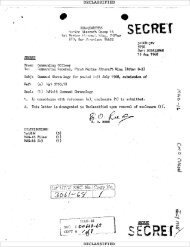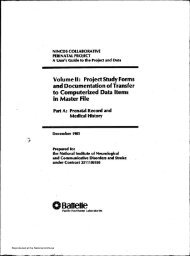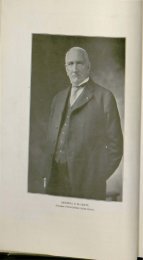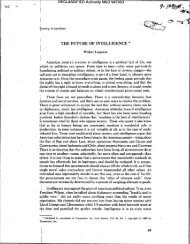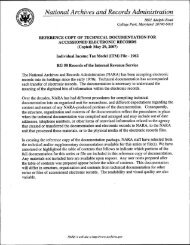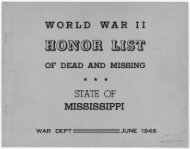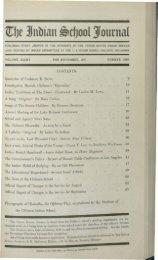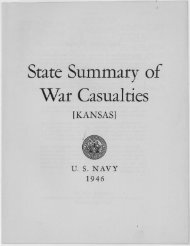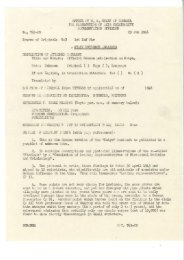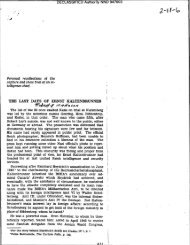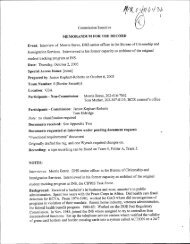MEMORANDUM FOR THE RECORD ATCSCC - Overview
MEMORANDUM FOR THE RECORD ATCSCC - Overview
MEMORANDUM FOR THE RECORD ATCSCC - Overview
You also want an ePaper? Increase the reach of your titles
YUMPU automatically turns print PDFs into web optimized ePapers that Google loves.
COMMISSION SENSITIVE<br />
UNCLASSIFIED<br />
<strong>MEMORANDUM</strong> <strong>FOR</strong> <strong>THE</strong> <strong>RECORD</strong><br />
Event: Visit to the FAA Air Traffic Control System Command Center ("<strong>ATCSCC</strong>" or<br />
"Command Center") in Herndon, VA and Dulles Airport Control Tower<br />
Type of event: Site Visit and Briefing<br />
Date: July 22, 2003<br />
Special Access Issues: None<br />
Prepared by: Lisa Sullivan<br />
Team Number: 7 and 8<br />
Location: Herndon <strong>ATCSCC</strong> and Dulles Airport<br />
Participants (Non-Commission) <strong>ATCSCC</strong>: Shirley Miller; Linda Schuessler, Air Traffic<br />
Tactical Operations - Manager Tactical Operations Division (on 9-11); Peter Lynch, FAA·<br />
Counsel; John White, Air Traffic Tactical Operations - Manager System Efficiency<br />
Division; Jack Kies, Air Traffic Tactical Operations - Manager Tactical Operations<br />
Division<br />
Participants (Non-Commission) Dulles: Shirley Miller; Linda Schuessler; ADD<br />
LAWYER; Charlotte Happle, Dulles Air Traffic Control Tower Assistant Manager;<br />
Michael Hawrysko, Dulles Air Traffic Control Operations Manager<br />
Participants - Commission (both facilities): John Farmer, John Azzarello, Dana Hyde,<br />
Miles Kara, John Raidt, Bill Johnstone and Lisa Sullivan<br />
<strong>ATCSCC</strong> - <strong>Overview</strong><br />
[U] Shirley Miller arranged this briefing for Commission participants. Linda Schuessler,<br />
the manager of the Command Center on 9/11, accompanied us on the visit as did Peter<br />
Lynch of the FAA Counsel's Office. Once at the Command Center Jack Kies led us on a<br />
tour of the facility. Participants first observed a Strategic Planning Teleconference (see<br />
below) and then toured the various areas of the main operations room. Participants then<br />
convened in a conference room to discuss the actual events of 9/11:, directing questions<br />
primarily at Linda Schuessler and John White. Total time of visit was approximately two<br />
hours.<br />
[U] The Command Center in Herndon became fully operational in 1996 [CORRECT? I<br />
thought it opened in 1997 but didn't become fully operational until a year or so later.].<br />
Its primary purpose is to monitor the flow of air traffic from a system-wide perspective,<br />
combine data from the individual FAA centers, and adjust the flow of air traffic based on<br />
weather forecasts and to make decisions regarding capacity and demand of the national<br />
COMMISSION SENSITIVE<br />
UNCLASSIFIED<br />
1
COMMISSION SENSITIVE<br />
UNCLASSIFIED<br />
air space. According to Jack Kies, on average, there are 6,000 -7,500 aircraft in the<br />
national airspace at any given time; a third of which the FAA does not track.<br />
[U] The floor of the Command Center is divided into four tiers. The first tier is made up<br />
of the weather monitoring group; the second tier is the Air Traffic Control area (divided<br />
into sections that handle the 21 ATC en-route facilities by section of the country); the<br />
third tier is the Command Center management; the fourth tier is the liaison desks for<br />
customers, including the military. Controllers at Central Command are assigned to an<br />
area/region of the country and he/she communicates between those facilities and the<br />
Command Center. These controllers report to the National Operations Managers (NAMs)<br />
on duty that have the authority to make decisions and hand down directives.<br />
[U] As a means of enhancing communication with the Command Center and providing<br />
effective service to the airlines, other major organizations are represented at the<br />
Command Center such as the Air Transport Association (which represents the air<br />
carriers); the National Business Association; the Airways Facility; flight inspection<br />
officials; and a Central Alternate Reservations Facility (CARP) operated by FAA<br />
officials with security clearances to conduct military aircraft exercises. The military also<br />
maintains a cell at the Command Center.<br />
[U] Every two hours, the Command Center hosts a Strategic Planning Teleconference<br />
(SPT) that includes all customers and users of the National Air Space system, including<br />
participants from the various flight control centers around the nation. They discuss<br />
weather fronts, projected delays, and essentially lay-out the day's plan for the nation's air<br />
travel. The teleconferences represent one dimension of the multilayered system of<br />
communication engaged in by the Command Center, en-route Centers, and some of the<br />
larger Traffic Control Centers (TRACON).<br />
[U] In the event that the <strong>ATCSCC</strong> became inoperable, Mr. Kies stated that there are<br />
several back-up centers.<br />
[U] Kies indicated that all operations phones are recorded. With respect to administrative<br />
phones, hesaid some are recorded and some aren't.<br />
Traffic Situation Display (TSD)<br />
[U] The computer program used at the Command Center to monitor the flow of air traffic<br />
is called Traffic Situation Display ("TSD"). TSD receives radar data from field facilities<br />
by satellite communication and displays such data at the Command Center. The<br />
computer displays at the Command Center are not in "real-time"; the information is<br />
delayed approximately 1 - 5 minutes. In terms of technical capability, the Command<br />
Center can isolate one radar track of a plane, but it cannot "see" the radar information<br />
that an air traffic controller tracking the plane can view on his or her radar screen. TSD<br />
does not transmit transponder information (i.e., altitude, speed, etc.,) to the Command<br />
Center [CORRECT?]. The Command Center does not talk directly to pilots, and it does<br />
not transmit text messages to pilots in the cockpits. However, the Command Center talks<br />
COMMISSION SENSITIVE<br />
UNCLASSIFIED<br />
2
COMMISSION SENSITIVE<br />
UNCLASSIFIED<br />
to the airline dispatch centers that then can forward text messages to pilots through the<br />
"ACARS" system.<br />
[U] Air carriers, businesses and individuals may access TSD data by purchasing software<br />
from the FAA or through the internet via a subscription service such as www.trip.com.<br />
Trip.com users can access the speed and altitude of commercial aircraft that have<br />
activated their transponders. Commission staff questioned the FAA participants about<br />
safety concerns related to TSD, given that it is readily accessible through the internet.<br />
Mr. Kies stated that the FAA "combs" the feed sent to subscribers and excludes<br />
information and data related to the movement of Air Force One, military aircraft, U.S.<br />
Customs aircraft and other government aircraft. Similarly, the National Business<br />
Aviation Association has filtered certain information from the TSD related to the<br />
movement of corporate jets. Both the FAA and the TSA have evaluated the data<br />
distributed over the TSD system and determined that the information provided to<br />
consumers through the sale ofTSD does not present a threat to national security.<br />
The National Airspace System (NAS)<br />
[U] The National Air Space is divided between ATC towers, TRACON Centers, and enroute<br />
Centers. Airport Ground Control puts pilots in the "system" once they are cleared<br />
for departure. The ATC tower gets the plane in position for take-off and tracks the plane<br />
within the tower's air space after take-off. The TRACON picks up the track of the plane<br />
once it leaves the tower's airspace. The en-route Center, which has more air space than<br />
the tower and TRACON center, works the plane through the air space system. There are<br />
21 en-route Centers located domestically, with a higher percentage of them concentrated<br />
. in the Boston, Chicago, and Miami "triangle." Some FAA Centers do not have primary<br />
radar capability. In recent years, the FAA has consolidated TRACON facilities at<br />
individual airports in areas of high volume air traffic to one TRACON that tracks flights<br />
from 3-5 airports or bases. This has already taken effect in areas around cities such as<br />
New York, Miami, and Washington-Baltimore.<br />
On September 11t\ 2001<br />
[U] Jack Kies said that the <strong>ATCSCC</strong> was the eyes and ears for information gathering on<br />
9-11. They possessed all the coordinated information for the system on that day. Linda<br />
indicated that while there was a military liaison presence at the command center (attached<br />
to the Air Traffic Services Cell), it was greater than usual on 9-11 because of previously<br />
scheduled activity.<br />
[U] Linda Schuessler was the <strong>ATCSCC</strong> operations manager on duty that morning. She<br />
was in a staff meeting in the conference room adjacent to the Command Center floor<br />
(now the national Capitol Region Council Command Center) when she received word of<br />
CNN's report that a general aviation flight had hit the World Trade Center North Tower.<br />
Controllers were engaged in a standard SPT at the time. John White, who was on the<br />
Command Center floor, interrupted Schuessler from her meeting a second time to inform<br />
her that a second plane, clearly a commercial jet, had hit the other tower. The meeting<br />
COMMISSION SENSITIVE<br />
UNCLASSIFIED<br />
3
•<br />
•<br />
•<br />
COMMISSION SENSITIVE<br />
UNCLASSIFIED<br />
adjourned and all the participants including Schuessler joined White on the Command<br />
Center floor to watch CNN on the big screen.<br />
(U] Schuessler asked controllers at each regional desk to call their field facilities and ask<br />
them to report any unusual occurrences, such as loss of radar. A total of 11 unusual<br />
instances were reported. One man kept track of the reports on a white board on the<br />
Command Center floor. Another individual called out to field facilities to follow up on<br />
the reports. John White said that he heard a controller in "strategic planning" calling the<br />
airlines to tell them what was going on. White said that <strong>ATCSCC</strong> (unsure if it was the<br />
controller in strategic planning or someone else) contacted the airlines' dispatchers about<br />
notifying their aircraft to beware of cockpit intrusion. White said that while it was up to<br />
the airlines to make the effort, "the expectation was that they would have contacted their<br />
aircraft." No indication was give about what time these notifications to the airlines were<br />
made. Every three minutes Schuessler and the two national operations managers<br />
(NAMs) on duty that morning (one of whom was Ben Sliney) would huddle in the center<br />
of the room and share information. The threat was determined to be .terrorism after the<br />
second plane hit the WTC. "After the second plane hit the WTC and prior to the plane<br />
hitting the Pentagon, we made the conscious decision to ground all flights," reported<br />
Schuessler. In the strategic planning area on the floor, the controllers began calling all the<br />
air carriers to report that "FAA Command Center was notifying all the ATCs, and<br />
advis[ing] the Airlines to alert their crews" that the Command Center was grounding all<br />
flights. [CORRECT? Please fill in the context here if you have notes on it]<br />
(U] Meanwhile, John White was talking to the FAA Operations Center about the<br />
information the Command Center was receiving. Mr. White was speakjng to, among<br />
others, Jeff Griffith (Special Assistant to Air Traffic Services),[ ~n~.. ___<br />
[QUESTION: ADD reference to David Canoles (who now heads the Washington<br />
Operations Center) on the teleconference with the Air TrafficInvestigation Office from<br />
the Command Center conference room - what is this about???] .<br />
;' .'<br />
[U] In addition, Mr. White stated that he and others at the Command Center were calling<br />
various military bases on 9-11 in search of military assets.rsuch as fighter aircraft, to<br />
defend the surrounding air space. Mr. White stated that "we [the FAA Command Center]<br />
became the Department of Defense" on 9111. ' :<br />
, .<br />
. [U] When asked about the military presence at the Command Center, FAA staff<br />
confirmed that because the CARF team had a scheduled military' movement exercise that<br />
day, military personnel were on hand to help man the phones in the conference room. It<br />
was not clear, however, who these military personnel.communicated with or what exact<br />
role they played. . .<br />
. .'<br />
[U] When asked about hijacking protocols and procedures, John White stated that he<br />
believed that Claudio Manno, the hijack coordinator forthe FAA, reported directly to the<br />
Aviation Control Center ("ACC") on 9-11 sometime after the first plane hit the WTC. In<br />
a separate exchange with Mr. Kies, he stated that.thestandard operating procedure in a<br />
hijack situation is for a controller to cal1 the supervisor and "notify the military." John .<br />
COMMISSION/SENSITIVE<br />
UNC LAS,'S IF lED<br />
9/11 Working-level Employee<br />
4
COMMISSION SENSITIVE<br />
UNCLASSIFIED<br />
[U] White said that the command center was "calling all over the military bases to find<br />
assets. It was very difficult to get anyone." He mentioned who they were looking for jets,<br />
air carriers -- anything to respond. (The sense given to commission staffwas that the<br />
search for military assets was ad hoc).<br />
[U] FAA staff repeatedly emphasized that the Command Center was in constant<br />
communication with approximately 11-13 FAA facilities on September 11, 2001<br />
[QUESTION: where does this number come from? There are more than that, correct?].<br />
John White stated that the Command Center had significant information on all hijacked<br />
airplanes except for American flight 77. White said that AA 77 was the only flight about<br />
which they were "disappointed" because they didn't have information. White or Kies<br />
indicated that AA 77 got all the way to Virginia before they picked up the primary target<br />
on radar. John indicated that there's a gap in radar coverage at certain altitudes which<br />
can contribute to the problem. White further reported the Command Center had "great<br />
information" on United Airlines flight 93. According to White, FAA Cleveland Center<br />
tracked AA 77 until sometime after 9:00 a.m. when it disappeared from radar. The<br />
Command Center thought AA 77 had crashed shortly after it disappeared from radar.<br />
FAA lost primary radar on AA 77 on the morning of 9~11. Since there is a gap in<br />
primary radar coverage somewhere over Ohio, White theorized that AA 77 may have<br />
been lost in Cleveland Center because it traveled through the zone that lacked primary<br />
radar capabilities.<br />
[U] John White spoke often with FAA Headquarters on 9-11. According to White and<br />
Schuessler the command center had a lot of reports of strange acting aircraft that day.<br />
They added a lot of "inaccurate reports" flowed into the Command Center on 9-11. With<br />
respect to AA 11, White speculated that a "tag jump" may have generated reports that<br />
AA 11 was airborne after it crashed into WTC One. A "tag jump" could have occurred<br />
because when a plane turns its transponder off, it is referred to as "coasting." The plane<br />
does not "disappear" from the screen when this happens; the controller is simply unable<br />
to find any specific information on the plane. The host computer will continue to look for<br />
the plane in the system after it loses the transponder signal. Specifically, the host<br />
computer will attempt to locate the plane through tracking its primary radar return. It is<br />
possible that the host computer could identify the wrong target in such a search.<br />
[U] White indicated he may have talked to the military on 9-11. If he called the military<br />
(i.e., NORAD) on 9-11, White believes he would have called CONUS at Cheyenne<br />
Mountain in Colorado. The Command Center was cognizant that the military lacked the<br />
radar capability to look inside the U.S. airspace on 9-11.<br />
[U] Schuessler ordered all non-essential persons on the physical plant of the Command<br />
Center to leave the premises. The nation-wide ground stop was verbally communicated to<br />
controllers in the field and planes were actually brought down after the Pentagon was hit.<br />
The Command Center made the decision to bring down all air traffic after the Pentagon<br />
was hit. Ms. Schuessler indicated that that option was considered before the Pentagon<br />
was hit - when the Command Center made the decision to ground stop all aircraft'~ but<br />
that course was not chosen. After the Pentagon was hit, the Command Center decided to<br />
COMMISSION SENSITIVE<br />
UNCLASSIFIED<br />
5
•<br />
•<br />
•<br />
COMMISSION SENSITIVE<br />
UNCLASSIFIED<br />
bring down all air traffic and started communicating that order to the field. Subsequently<br />
the Command Center sought and received approval for this decision from DOT Secretary<br />
Mineta.<br />
[UJ In response to Miles Kara's question whether or not SCAT ANA (security control of<br />
air traffic and navigation aids) was declared by the military, Schuessler explained that<br />
declaring SCAT ANA would necessitate not only bringing down all aircraft, but also<br />
force the FAA to turn off all navigational equipment and relinquish control of the NAS to<br />
the military. According to Schuessler, SCAT ANA was never called for reasons related to<br />
the FAA's need to maintain control over navigational equipment'. Therefore, the airspace<br />
was not transferred from the FAA to the military on 9-1l. In the briefing, none of the<br />
FAA staff had recollection of a special ops flight out of BWI to Pope AFB that day; nor<br />
did they recol1ect the C-130 that passed over the Pennsylvania crash site that morning.<br />
[U] According to Mr. Kies, "The only shot controllers at Boston Center and Rome, NY<br />
had of finding the planes was to stay on the phone with each other." Without a<br />
transponder signal, the controllers resorted to primary radar to locate and manually track<br />
flights AAll and UA175. He explained that primary radar relies on the controller's<br />
observation. The controller must contend with a Jot of c1utter on the screen. The<br />
assurance of a positive identification of a target increases only with time. Long-range,<br />
secondary radar tracks traffic at higher altitudes and identifies flights with absolute<br />
certainty. Turning off the transponder in the plane disables secondary radar. The FAA is<br />
looking into installing permanent transponders in aircraft) making it impossible for pilots<br />
to tum the device off.<br />
Potential Additional Disasters Averted on 9-11:<br />
[U] Jack Kies states that he is absolutely certain that the grounding order that was<br />
affected by <strong>ATCSCC</strong> (not Sec. Minetal stoard other terrorist plots from occurring. Jack<br />
referred to an individual namedl ho works for NavCanada who told him that<br />
Air Canada had a plane scheduled to depart Toronto Canada and arrive at JFK<br />
International Airport in New York on 9-11. According to.1 Ithat plane never got<br />
off the ground and authorities found box cutters secreted ... in the luggage compartments in<br />
the first class section of the aircraft and two people who/fit a terrorist profile on board.<br />
Jack Kies also mentioned the St. Louis incident in which two passengers on a flight that<br />
landed after the grounding order, fled the plane and hopped a train.<br />
,<br />
<strong>ATCSCC</strong> in Emergency Situations<br />
. , . , .<br />
[U] Jack Kies indicated that decision-making for the/National Air Space system,<br />
including in times of emergency) rests with the <strong>ATCSCC</strong>. He seemed to indicate that<br />
decision-making generated from the command center was even above the WOC. Kies<br />
stated, "The buck stops here." ':<br />
[U] Either John or Jack said the procedure caiIs for getting the military up to follow a<br />
hij acked aircraft. ' ,<br />
, .<br />
COMMISSION/SENSITIVE 6<br />
UNCLAS:SIFIED<br />
9/11 Working-level Employee
•<br />
•<br />
•••••••<br />
Miscellaneous<br />
COMMISSION SENSITIVE<br />
UNCLASSIFIED<br />
[U] Shirley Miller was queried on whether there were any "lessons learned" on how the<br />
system worked on 9-1l. She indicated she was unaware of any.<br />
Second Site Visit to Dulles Air Traffic Control<br />
[U] The Dulles A TC tower is operated by 10-11 controllers and is approximately 40<br />
years old. Dulles operates 24 hours a day and 7 days a week. On 9-11-01, Dulles had its<br />
own TRACON, which was moved to Potomac, Maryland on December 17, 2002, where a<br />
large TRACON facility was built to service Dulles, Washington Reagan, BWI, Andrews<br />
AFB, and Richmond. On 9-11, the Dul1es TRACON was located on the 1z" floor of the<br />
tower. The facility has a direct line to the White House (U.S. Secret Service) which they<br />
test on a weekly basis, according toJ I A white telephone marked "WH" is<br />
located on the wall of the rz" floor in the old TRACON area. The Dulles facility is run<br />
by Metropolitan Washington Airport Authority. Personnel did confirm there was a direct<br />
1ink to the White House from the TRACON on 9-11 (CAN SOMEONE ELSE<br />
CONFIRM WHAT I BELIE~]~ <strong>THE</strong>Y TOLD US).<br />
[U] Dulles ATC owns and controls a 7.5 mile radius of airspace up to an altitude 0[2,000<br />
feet. The Dulles local controllers pass flights to the TRACON facility which, in tum,<br />
passes flightsto FAA "en-route" centers. The ramp tower, which is operated by the<br />
airlines or private entities, controls ramps and gates at the airport .<br />
[U] The Dunes A T~/rower generally has 2 ground controllers, 2 local controllers who<br />
dear planes for departure and 1 supervisor. The tower also has a flight data controlIer<br />
who records basic.flight information (e.g., destination, flight altitudes, etc.). The tower<br />
has an AMASS:~ystem designed to prevent runway .incursions.<br />
Dulles ATe ?t1 September 11th<br />
[U) r . fhe supervisor of Dulles Tower and TRACON, arrived for work<br />
at ~':OO a.m. on Septem er 11,2001. AA 77 took off frornrunwa 3 and tracked the path<br />
ofHighway 29 (also referred to as the "Dulles corridor"). first heard of the<br />
World trade Center attack in the break room (on thy,,12 1h<br />
I<br />
oor) e ow the tower.<br />
Isaw CNN's footage of AA 11 and UA'175 striking the WTC towers. The<br />
/;;'persqrmel we met with said they received theirinformation from CNN. The Washington<br />
;';' en-route Center notified Dulles' TRACOr-i facility of the World Trade Center crashes.<br />
,/,/ Washington Center advised Dulles,.TRA.CON to look for any suspicious aircraft activity<br />
and asked TRACON if it had anyinformation regarding AA 77. Specifically,<br />
:; ....Washington Center talkedtothe Traffic Management Coordinator in Dulles TRACON<br />
,// :/ regarding AA 77. Washington Center advised Dulles that AA 77 was "unaccounted for."<br />
:: :' And to keep a look-out for)t.1 hold Air Traffic Management that AA<br />
77 had indeed.departedfrom Dulles and gave them the exact time of take-off. He began<br />
searching.for the.flight on Dulles TRACON's primary radar, which Dulles Tower always<br />
displays:"A.-cc6'rdi~g,tol Ithe supervisor of Dul1es TRACON called the White<br />
......<br />
......<br />
9/11 Working-level Employee<br />
COMMISSION SENSITIVE<br />
UNCLASSfFIED<br />
7
' .. 9/11 Working-level Employee<br />
..<br />
•<br />
•<br />
COMMISSION SENSITIVE<br />
UNCLASSIFIED<br />
[U] House on the direct telephone line and advised the U.S. Secret Service that AA 77<br />
had just flown over Dulles at a high rate of speed and was headed towards Washington,<br />
D.C. In addition.Dulles TRACON's supervisor notified National Airport via a direct<br />
telephone line tha"t"A;\ 77 was quickly approaching the area. Dulles TRACON also called<br />
Washington Center Traffic Management and Herndon Command Center to warn them<br />
about the plane that sped ove{.Dulles and was speeding towards the Washington, D.C.<br />
Capital region. During that timeJ ~aid that he was also looking for another<br />
\"United Airlines jet that was reported missing. It was not until after the plane hit the<br />
"'Pentagon that they realized it was AA 77. Personnel we met with said there was not<br />
discussion of notifying the Capito\.<br />
[U],... [noted that Dulles initially heard that AA 77 had struck the WTC's North<br />
"\Tower.<br />
tU] Dulles Tower received word from Traffic Management at Washington Center to<br />
"sterilize airspace." Command Center had initiated this order to ground all flights. This<br />
occurred after the Pentagon was struck by AA 77.<br />
[U]'I ~as not aware that a C-130 military aircraft was in the airspace and<br />
had attempted to identify AA 77. While protocol existed on 9-11 for Dulles TRACON to<br />
notify Washington Center Traffic Management, Herndon Command Center and the FAA<br />
Regional Operations Centers, no such protocol existed to notify the military .<br />
[UJ The personnel we talked with were unaware of any actions taken to check the<br />
grounded airplanes for terrorists once they were grounded by the order to clear the skies.<br />
Changes Implemented after September 11th:<br />
[U] Subsequent to the events of September n", the FAA developed a "more robust"<br />
communications system.· Washington Operations Center Headquarters' Air Traffic<br />
Management has a moderator on an open telephone line that connects all major<br />
TRACONs, traffic management centers and "tower caps" in the United States.<br />
Procedures for flight crew in the event of a hijacking or in response to suspicious activity<br />
are broadcast over the Domestic Event Network (DEN) which includes the military, the<br />
Herndon Command Center, larger TRACONs and en-route Centers. The DEN is run by<br />
the Washington Operations Center 24/7.1<br />
9/11 Closed by Statute<br />
...... .......1 The creation and implementation of DEN is a significant change in<br />
the system since September 11tho .<br />
[UJ The FAA has initiated crisis management drills with Department of Homeland<br />
Security focused on, "what if?" scenarios.<br />
COMMISSION SENSITIVE<br />
UNCLASSIFIED<br />
8
COMMISSION SENSITIVE<br />
UNCLASSIFIED<br />
[U] Of the hundreds of radar facilities Iocated throughout the country, the military only<br />
attached itself to coastal locations before 9-11-01 because it positioned itself to detect a<br />
threat coming from abroad, rather than within the 1).S. borders. Now, the military has<br />
access to all domestic radar.<br />
Miscellaneous<br />
[U] --Dulles is the diversion airport for airplanes going into National that show some kind<br />
of problem or suspicious activity, including NORDO, transponder off, airspace violation,<br />
course deviation, etc.<br />
[U] --TSA is doing a MANP AD assessment at airports. One of the Dulles personnel we<br />
talked to thought it was a matter of when, not if, an airplane is attacked by a MANP AD.<br />
[U] --When asked about the subject, one of the personnel indicated that he was concerned<br />
the heightened profile and awareness for security issues can take the controllers eye off of<br />
managing aircraft and airspace.<br />
Follow Up<br />
[U] Shirley Miller said she would try to obtain for the Commission copies of the recorded<br />
phone conversations from Command Center on September 11th. She reiterated that calls<br />
on administrative lines were not all recorded. Miller could not say with certainty if there<br />
was an "after-action" report done by the FAA following the attacks. She responded that<br />
routinely voice/data information is collected and given to the Air Traffic Investigation<br />
Office. David Knowles synthesized that information into a book organized by flight after<br />
September 11tho That information was delivered to the National Transportation Safety<br />
Board, which ultimately turned it over to the FBI for the criminal investigation. The<br />
NTSB, for its part in the investigation, corroborated the FBI's findings that the attacks<br />
were not attributed to a mishap on the part of the FAA, but rather, to the deliberate steps<br />
taken by the terrorists. Again, Miller promised to advise the Commission whether a<br />
narrative and/or after-action report was written after the attacks.<br />
COMMISSION SENSITIVE<br />
UNCLASSIFIED<br />
9




